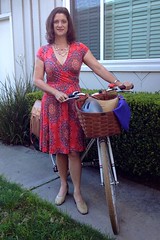In the mid-90s I bought an inexpensive mountain bike to ride around town. I fell in love with that bike and rode it longer and longer distances until I realized I could do the 10 or so miles to my job in San Jose, not far from where I work today. I had rear rack to carry my clothes, a locker room with a shower at work, and a safe place to store my bike. My only issue was finding a bike-friendly route to get there.
The problem was that my office was across the freeway from my home and the only crossings were on high-speed, heavy-traffic roads. The answer came at my company’s health fair where a volunteer from the Silicon Valley Bicycle Coalition helped me find a less obvious, better freeway crossing plus a more mellow route along the bay. It was about an hour each way, so I only rode 1-2 times per week, and only during summer.

Riding a few miles south on that bayside route takes me to my current job near the San Jose airport, a 14 mile trip that’s half on moderate traffic roads and half on bay and creek trails. The more direct alternative is 11 miles on Central Expressway which has a wide shoulder, but cars moving at close to freeway speeds. Not my idea of fun. And strangely, the longer bay route is almost as fast since there are fewer stops.
The Advantages: Riding over two hours a day is a great way to get in shape. You can take it easy for base training or work hard in intervals for true training. With a good route like the Bay Trail you can get some fresh air and enjoy nature on the way to work. And it’s virtually free, about 5 cents per mile for bike wear and tear.
The Disadvantages: Finding a good route isn’t always easy and road construction can leave you stranded without options. You need to pack and carry clothes and preferably have a shower if your ride is over 8-10 miles. Unless you’re wanting the training time, longer rides are tough to do both ways every day. My route is windy in evening which adds 5-10 minutes. Riding a road bike to lunch may not be comfortable in your work clothes, and you’ll likely have limited bag space for shopping after work.

The Upshot: A great way to get a workout if you have a good route and a shower at work, but don’t expect to do this kind of commute every day.
Next up in the Anything Goes Commute Challenge is VTA Light Rail. Can you guess how it will compare?







Richard Masoner (@cyclelicious)
April 11, 2013 at 11:15 am
Can you do 100% light rail from where you live? You’ll probably have to either bike to the LRT station or at least get dropped off there, right?
The light rail ride from MV to Metro Airport station is 45 minutes and costs $2 if you pay a per ride pass. Exercise time is however long it takes you to walk to and from the platform (15 minutes?) Reading time is your entire train trip. No need to pack clothing. Lunch and shopping options are about as limited as biking. No bugs to eat on the way, though you also miss the wonderful views along the Bay. I like light rail when it’s raining or if I’m feeling under the weather.
Another transit option is VTA 522 and VTA 10, which is again about a 45 minute ride total, though I think your walk to work is probably a little longer. Finally, you can also take 522 all the way to downtown San Jose, and then catch either light rail or VTA 66 up 1st Street to the office. That final option is two different trips which doubles the cost unless you have a day pass or monthly pass.
ladyfleur
April 11, 2013 at 11:46 am
I live 1 mile from MV light rail station and work about 1/2 from Gish/metro stations so I can do it on foot. But as you’ll see in my next post I take a shortcut.
The problem with the 522 bus is that E l Camino is close to two miles from my house and I have to transfer to get close to the office or take a bike. So Caltrain is better all around.